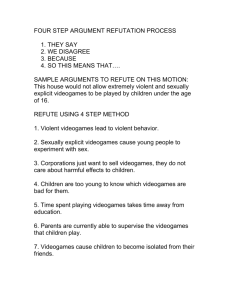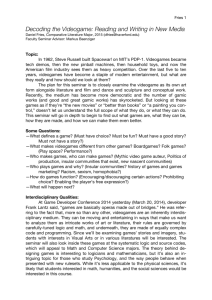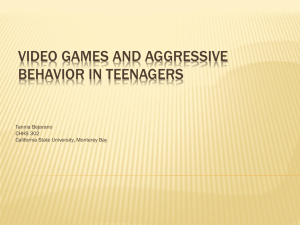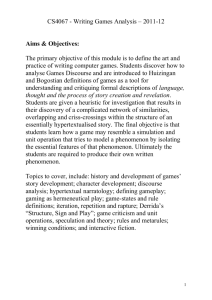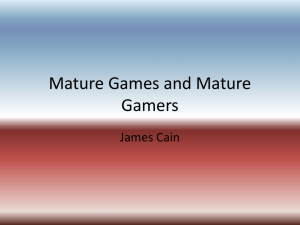BusinessWeek 09-14-06 It's Addictive! Or Is It?
advertisement
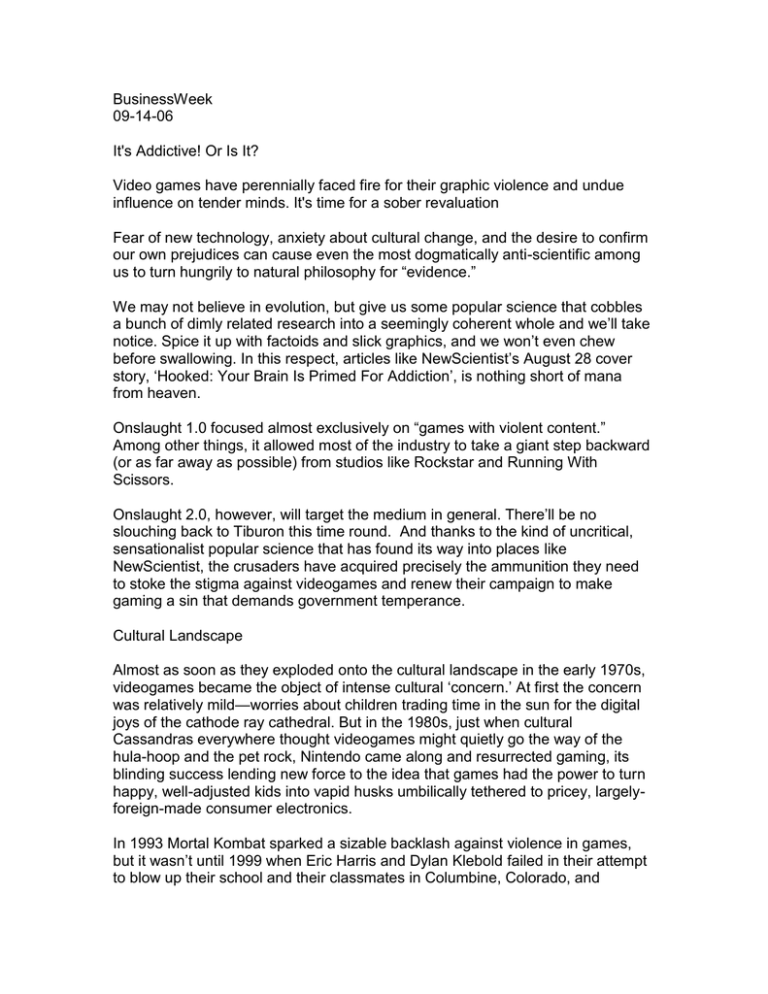
BusinessWeek 09-14-06 It's Addictive! Or Is It? Video games have perennially faced fire for their graphic violence and undue influence on tender minds. It's time for a sober revaluation Fear of new technology, anxiety about cultural change, and the desire to confirm our own prejudices can cause even the most dogmatically anti-scientific among us to turn hungrily to natural philosophy for “evidence.” We may not believe in evolution, but give us some popular science that cobbles a bunch of dimly related research into a seemingly coherent whole and we’ll take notice. Spice it up with factoids and slick graphics, and we won’t even chew before swallowing. In this respect, articles like NewScientist’s August 28 cover story, ‘Hooked: Your Brain Is Primed For Addiction’, is nothing short of mana from heaven. Onslaught 1.0 focused almost exclusively on “games with violent content.” Among other things, it allowed most of the industry to take a giant step backward (or as far away as possible) from studios like Rockstar and Running With Scissors. Onslaught 2.0, however, will target the medium in general. There’ll be no slouching back to Tiburon this time round. And thanks to the kind of uncritical, sensationalist popular science that has found its way into places like NewScientist, the crusaders have acquired precisely the ammunition they need to stoke the stigma against videogames and renew their campaign to make gaming a sin that demands government temperance. Cultural Landscape Almost as soon as they exploded onto the cultural landscape in the early 1970s, videogames became the object of intense cultural ‘concern.’ At first the concern was relatively mild—worries about children trading time in the sun for the digital joys of the cathode ray cathedral. But in the 1980s, just when cultural Cassandras everywhere thought videogames might quietly go the way of the hula-hoop and the pet rock, Nintendo came along and resurrected gaming, its blinding success lending new force to the idea that games had the power to turn happy, well-adjusted kids into vapid husks umbilically tethered to pricey, largelyforeign-made consumer electronics. In 1993 Mortal Kombat sparked a sizable backlash against violence in games, but it wasn’t until 1999 when Eric Harris and Dylan Klebold failed in their attempt to blow up their school and their classmates in Columbine, Colorado, and murdered 13 children in the process, that family-friendly vigilantes, poll-wearied politicians and media effects mavens started to take serious regulatory aim at gaming culture. Around 1999, roughly coinciding with an appearance on 60 Minutes the Sunday after the Columbine shooting—the same episode that introduced the gaming world to Jack Thompson—retired Army psychologist and former Ranger, Lt. Colonel David Grossman, began offering a view of videogames that would drive regulatory legislation into the next century. “I sincerely believe that if [legislation] is not passed we will pay a tragic price in lives, just as surely as if we had failed to keep guns or alcohol or tobacco out of the hands of kids.” Jack Thompson, among others, took the idea—as well as Grossman’s favorite phrase, ‘murder simulator’—and began shopping it around state legislatures, resulting in the passage of myriad videogame bills over the next five years. The basic strategy was to press the claim that rather than being protected speech, violent videogames should be considered ‘harmful products’ just like alcohol, tobacco and firearms. As such, the government is within its jurisdiction to restrict their access by children. It was a novel and bold approach—no expressive medium in the history of American society had been so radically recast as dangerous contraband. The problem, however, was demonstrating that violent videogames are actually harmful to kids. Although Grossman and Thompson and people like National Institute on Media and Family founder David Walsh had seen enough to convince themselves, they needed science to back up their claims and win over recalcitrant politicians, frightened parents, and bored pundits. They hit the jackpot with Craig Anderson. On March 21, 2000, Dr. Anderson—Chair of the Department of Psychology at Iowa State University—testified before the U.S. Senate Commerce Committee’s hearing on the “impact of interactive violence on children.” Anderson introduced himself to the committee as an expert on videogame violence and children, testifying that Social Psychology “My first publication on videogame violence appeared in 1987. Next month the American Psychological Association will publish a new research article on videogames and violence that I wrote with a colleague of mine (Karen Dill). The article will appear in the Journal of Personality and Social Psychology, the premier scientific outlet for research in social and personality phenomena.” Dr. Anderson, however, neglected to tell the committee that out of 46 scientific publications he authored between 1987 and the Columbine shootings in 1999, only two involved videogames and violence and only one (published in 1987) sought to analyze the media effects of violent games. In fact, while Anderson had indeed dedicated much of his research to aggression, almost none of it outside these two articles had anything to do with media effects in general. Regardless, Dr. Anderson confidently told the U.S. Senate Commerce Committee that , "Though there are many complexities in this realm of behavioral research, there is one clear and simple message that parents, educators, and public policy makers such as yourselves need to hear: Playing violent videogames can cause increases in aggression and violence.” Thompson and crew were ecstatic. Despite his slow start, and beginning less than a year after Columbine, Anderson was listed as an author on at least nine articles over the next five years that specifically linked videogames to aggressive thoughts and behavior. In fact, when Judge Matthew Kennelly struck down Illinois Governor Rod Blagojevich’s stab at game regulation, he noted that of the 17 scholarly articles submitted to support the statute, Dr. Anderson authored or co-authored no fewer than 14. The remaining two, the only studies of the bunch that employed brain imaging techniques, relied on Anderson’s research for their experimental design. The rest of the nation’s videogame legislation has succumbed to similar analysis. Onslaught 1.0 did not fail because its underlying strategy was rejected. The courts have accepted that state legislatures have a compelling interest in protecting children from harmful products. Instead, the courts have consistently found that the evidence supplied in support of video game laws is insufficient. The science was simply not there. Enter Onslaught 2.0: The Addiction Game. In retrospect, Onslaught 1.0 bit off more than it could chew from the beginning. Media effects are notoriously difficult to establish, and despite 50 years of studying television no one has been able to show negative effects compelling enough to justify anything more than restricting broadcast of certain programs to times of the day when children are unlikely to be viewing. Onslaught 2.0, however, is not a claim about the effect of videogame content, it’s a claim about the medium itself: Because videogames are an addictive product, 2.0 goes, they belong in the same class as tobacco, alcohol, and gambling, all of which are subject to regulation restricting access. And while the science is not there, the pure sensationalism of the claim is frightening enough to compel many to accept the claim blindly. Of course, videogame addiction is in itself anything but a new idea. Throughout its history, the incredibly compelling nature of games has moved gamers to use ‘addictive’ as a term of praise. In 2005, as 2.0 began to gather force, Ernest Adams pleaded with gamers to cease referring to their pastime as an addiction, since it’s so easily confused with psychological use of the term. In a recent review of the science, Neils Clark pointed out that there is an important distinction to be made between people getting addicted to videogames and the claim that videogames are in and of themselves an addictive product. Current science seems to support the former and has almost nothing to say about the latter. None of this, however, stopped NewScientist from including videogames among crack, nicotine, gambling, and nymphomania as things to which our brains are “primed for addiction.” Experience cravings Consider the presentation. An extremely underexposed image of three adolescent men before a suite of three, huge flatscreen monitors displaying a first-person shooter is accompanied by a caption that reads: “Some gamers experience cravings that are just as powerful as those felt by recovering crack addicts.” To the left is a breakout box entitled ‘The Computer Addict’ which details a ‘case history’ of a 16-year-old who spends 70 hours a week socializing with his friends online. Pepper this with giant pull quotes of statistical factoids—83% of 18-year-olds have a videogame player, 2 hours spent gaming each day in US households, 31 hours average spent online per month worldwide—sandwiched in among sinister stats about gambling and an illustration of a brain outlining dopamine release to the frontal lobes, and its hard to stave off an impression of impending DOOM. The problem is that the research cited in the article isn’t anywhere near compelling enough to justify the claim that games are genuinely addictive, yet there it is anyway, sandwiched in among drugs and gambling, both of which have been studied far longer and much more thoroughly. Nevertheless, it’s gaming that is consistently slipped into the article to make the piece seem interesting and urgent. For example, although it’s titled ‘The Computer Addict,’ the case history is taken almost verbatim from a journal article written by Mark Griffiths, a psychologist and longtime gambling researcher at Trent-Nottingham who is quoted in the piece. But in the original article, which reviewed five case histories of patients exhibiting ‘excessive computer use,’ Dr. Griffiths concluded that while two of the cases, including the one cited by NewScientist, could possibly be considered cases of addiction, it was not at all clear that they were in fact examples of addiction. In other words, the ‘computer addict’ might not have been an addict at all. But by making the case into a sidebar next to an ominous image of shadowy gamers playing violent videogames and titling it ‘The Computer Addict,’ NewScientist encouraged an altogether different interpretation. Then there’s the brain studies. Sabine Grüsser–Sinopoli, a researcher who uses a form of time-course EEG called evoked response potential (ERP) to study drug addicts, is quoted extensively throughout the piece, including the astonishingly flat proclamation that “addiction is all the same.” Grüsser–Sinopoli has used ERP to compare the ‘arousal’ reactions of drug addicts, gamblers and gamers to both neutral images and images associated with their compulsive behavior. If the acronym ERP looks familiar to you, it’s because ERP has been hailed by the proponents of Onslaught 1.0 for showing that “chronic exposure to violent videogames has lasting deleterious effects on brain function and behavior.” Last year Bruce Bartholow published a study where he showed neutral images, positive images and images of actual violence to a group of ‘violent videogame players’ and compared the resuts with a control group. The study, whose experimental design relied on Craig Anderson’s research, found that certain characteristic EEG peaks were diminished when players of violent videogames were shown images of actual violence. The control group did not exhibit this feature. Bartholow took this as evidence that violent videogame players were physiologically desensitized to actual violence. But an ERP study conducted by sports researcher Stephen Radlo that compared novice, intermediate and advanced batters’ responses to pitches found the very same relative diminution in characteristic peaks among advanced batters that Bartholow found with violent videogame players. Yet, instead of concluding that the advanced batters had become desensitized to pitches, Radlo concluded that the lack of reaction in the batters was due to cognitive efficiency—the advanced batters were able to quickly extract relevant cues in a dynamic situation and identify the pitch, using less cognitive power. This is consistent with previous findings that have associated the amplitude and latency of the characteristic peak (called the P300) with semantic evaluation, information processing and calculation of subjective probabilities. Plausible hypothesis A similar hypothesis could easily explain Bartholow’s findings—rather than being desensitized to violence, the violent videogame players’ brains were just more adept at extracting relevant cues and identifying violent images. It’s a very plausible hypothesis and one that Bartholow never even entertains in his paper. Although her ERP studies focused on a different characteristic peak, the failure to consider competing hypotheses also undermines many of Grüsser–Sinopoli’s claims. What she interpreted as signs of drug addict like emotional ‘arousal’ in gamers presented with surprise images of videogame cues could easily be accounted for by supposing that the ‘compulsive’ gamers responded strongly to the game images because they simply contained more semantic content that was relevant to them than the neutral images. The similarity in reactions among gamers and drug addicts shown images of places where they formerly used drugs, for example, could say more about the similarities among learning processes and addiction than they do about games being addictive. And that’s the rub with these kind of studies. ERP, for example, is extremely useful but it’s also incredibly low resolution, which makes it very easy to conflate distinct phenomena that yield similar experimental results. Despite numerous reasons to be skeptical about the conclusions drawn from research into games addiction, NewScientist devoted nearly a third of its space to policy changes that should be considered in light of this kind of ‘suggestive’ research, gaming included. For example, after describing studies where she observed that children are “more likely to turn to computer games when they are unhappy,” Grüsser–Sinopoli is quoted as saying that “We need to be made more aware of the potential risks, and we need as a society to worry about what we do, and remove subsidies for addictive behaviors, tobacco, gambling, state lotteries—it’s absurd.” Of course, scientists like Grüsser–Sinopoli aren’t Jack Thompson, to be sure. Grüsser–Sinopoli’s a well-respected scientist who has dedicated her career to the study of addiction. But the rising interest in videogame effects coupled with increased public apprehension about the ubiquity of videogames creates a climate that strongly encourages people to find ‘evidence’ that supports big claims—claims that make headlines, get one asked to testify before legislatures, and invited to make television appearances. Pretty soon, it becomes ‘accepted wisdom’ among the public and before you realize it, an expressive communication medium is transformed into harmful contraband. The NewScientist cover story closes with a sinister, if entirely vague quote from Peter Whybrow, author of American Mania: “If politicians and leaders understood how the brain works, they would not be building society as they are doing.” You can almost hear the family-friendly videogame vigilantes whispering, “I told you so.” Aaron Ruby is co-author of the book Smartbomb: The Quest for Art, Entertainment, and Big Bucks in the Videogame Revolution.
